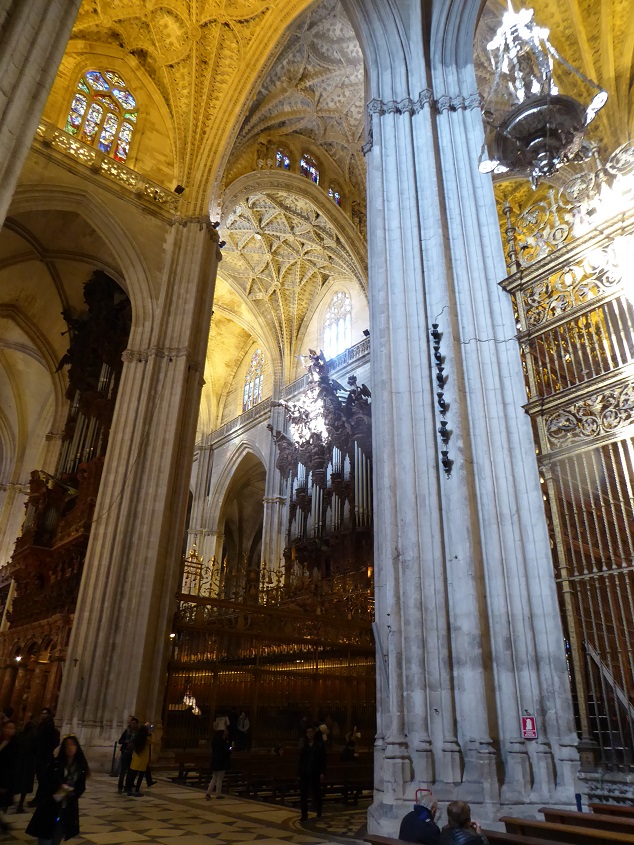We arrived in Seville about a week before Christmas. The streets were canopied in sparkling lights, carolers sang their sometimes beautiful harmonies, yellow wheeled horse drawn carriages clip-clopped by. Everyone was immaculately dressed. Even the children. Really, you’ve never seen such nice clothes on every single child before.
The city is so very alive. It is communal, extroverted. There are always people in the streets, crowding the standing room only tapas bars, their kids playing fútbol in any open square. There’s something wonderfully impromptu about it all. No one sets up the play date; everyone just knows where to be.
Though it was threatening to rain, we walked to the Plaza de España, which was built as part of the 1929 World’s Fair. It’s a big sweeping arc of a building with a moat (a moat!) separating the structure from the main plaza.


Having been built for the World’s Fair we can forgive it some extravagance. It’s meant to showcase Spain, and that it does. Each province gets its own alcove in tiled paintings along the arc of the building.

Since it hadn’t started raining on us just yet we decided to continue our walk towards the cathedral. Along the way we were treated to the constant smell of oranges from the trees that line the streets here. There are nearly a thousand of them if the things we’re reading can be believed. Being winter, the trees were loaded nearly to bursting with fruit. It smelled fantastic. No one ever picks an orange, though. It’s either a result of profound self-restraint on the part of the Sevillanos or there’s something wrong with the fruit. A quick Google search assured us it’s the latter. The oranges are bitter. The British use them for marmalade, but the Spanish believe they are secretly using the pith as gunpowder. Heh.
Once we made it to the cathedral it was hard not to recall a quote we’d read in our guide book about the place. No one knows who said it, or even if it was said at all, but it’s been part of the oral history of Seville for so long that it doesn’t matter anymore. “Let’s construct a church so large that future generations will think we were mad,” said some church official at some point in time. It took more than a hundred years to finish it, and it was financed by the parish clergy, who sacrificed half their stipends to pay for labor, artisans, and raw materials.
The end result is….big.

There are fifteen doors into the church, but us tourists don’t get to enter any of them. At least not on the day that we were there. We entered through the gift shop, which is next to the Prince’s Door. It is a beauty.


Once inside things got a little more confusing. We had the distinct impression that the designers of this place weren’t “mad” so much as they had bitten off more than they could chew.


There’s a lot of empty space, and no clean line of sight to the main altar. The church is lined by 80 chapels, each with some tremendous artwork. In the center is the high choir, which is normally situated above the main floor. The result is enough space for only a dozen rows of pews in between the choir and the main altar.


The cathedral is also the final resting place of Christopher Columbus, the explorer we all love to hate.

Probably one of the most fascinating pieces of art on display here is a large piece called the Vision of St. Anthony. In it, a kneeling St. Anthony is met by heraldic angels. It’s a masterpiece by the Spanish artist Murillo, but that’s only part of what makes it interesting. In 1874, someone took a knife to this thing. The thief cut out St. Anthony, rolled him up, and took him to New York. A discerning art dealer there recognized what he was looking at, bought the piece for $250 and mailed it back to Spain, where it was stitched back into the canvas.

This one painting is my favorite part of the cathedral, if only because of the story. I just love these kinds of details about a great painting that might otherwise just blend in with all the other great paintings.
The very large tower that stands beside the cathedral was once part of the original mosque. The architects incorporated it into the construction of the cathedral and it fits in marvelously.

If you’re coming to Seville, give yourself a good half day to go through the cathedral. It’s a lot to take in.
Next up: The Alcazar, which deserves its very own post.
Lovely captures!
LikeLiked by 1 person
Wow. That’s all I got. Wow…
LikeLiked by 1 person
What an awesome experience! Great photos.
LikeLike